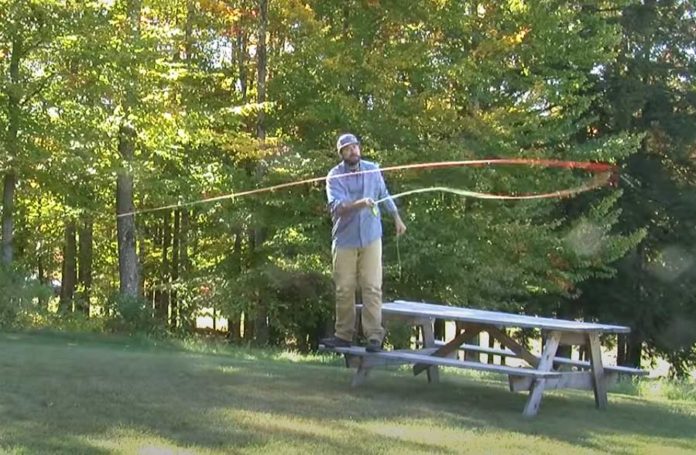Written by: Pete Kutzer, Orvis Fly-Fishing Schools
Accuracy is the most important aspect of fly fishing. Our main goal is to catch a fish, and in order to do that, we need to cast our fly close enough to the chosen fish to entice it to eat, without spooking it. Generally, fish are in the business of conserving calories, so counting on them to move to eat our fly doesn’t make for great odds. Of course, accuracy is best practiced somewhere far away from that fish. Luckily, most of us have access to some place far away from that fish right now–our own homes.
Let’s get down to the specifics: for an accurate cast, I want you to think about the shape of the loop rolling out to our target. The loop is described as two “legs”: the “fly leg,” the top half of the loop closest to your fly, and the “rod leg,” the bottom half of the loop. If the loop is “stacked” on top of itself–with the fly leg directly over the rod leg–and we apply the correct amount of energy into our cast, the line will turn over and land nice and straight: on target. You can imagine the fly going right over the top of the rod.
The photo below shows an example of a loop stacked on top of itself. As you’ve probably figured out, this is easier to accomplish with a very upright cast. The fly will have less likelihood to “kick” to the left or right at the end of our cast. Overhead casts are great, and understandably the most common casts seen when focusing on accuracy.

You’ve probably also figured out that when we’re fishing in the natural environment, overhead casts are not always an option. Imagine the wide variety of overhead obstacles found on your favorite trout stream, or the necessity of keeping a low profile while flats fishing: trying not to spook an actively feeding bonefish or carp by standing tall with a rod high in the air. Sometimes, a side-arm cast at a lower angle is the best (or only) option, requiring us to be able to adapt and change our casts to ever-changing environments and scenarios, all while maintaining accuracy.
What is the most common issue I see when casting side-arm? We tend to create a loop that lies flat on its side (horizontal to the ground) as opposed to a vertical loop, with the fly leg stacked on top of the rod leg.

Granted, that angle is great for getting your fly under a particularly low-hanging obstacle, but if we are not applying the right amount of energy to our cast–giving it either too much or too little power–our fly line, leader, and fly may “kick” to the left or right of our intended target. (In this instance, the elusive side-yard brown trout, often found holding over moss during quarantine.)

To work on getting an accurate side-arm cast, we must turn our loop over so we can get that accurate over-the-top loop when delivering our fly to our target. I like to use the analogy of turning a key while making your side-arm forward cast. By changing the angle of your wrist, you can change the orientation of your casting loop.
There are a few grip variations you can use while casting. I prefer to use a thumb-on-top grip. For me, it’s comfortable and I like to think that where my thumb goes, the rod tip goes.

When I come to a stop on my forward cast, getting my line to roll out my hand looks like I’m giving someone a “thumbs up.”

When I make a back cast, my thumb looks like I’m hitching a ride. (Does anyone hitch a ride anymore?)

To go from “hitching a ride” to “thumbs up,” we must subtly rotate our wrist like we are “turning a key” counterclockwise (for right-handed casters) while making the forward cast. This will make the loop go from horizontal to vertical, giving us a more accurate side-arm cast that won’t kick to the side.


Give this a shot and hopefully it will help you “unlock”
your accuracy potential.
(Sorry about that. I couldn’t help myself).
Good luck,

Pete Kutzer
Credit: Source link































